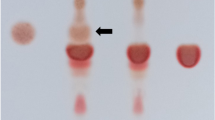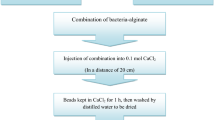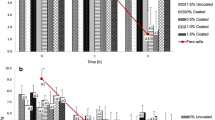Abstract
One of the famous traditional confectionery products is Tahini halva. The aim of this study was the production of probiotic halva using free Lactobacillus acidophilus (FLA) and microencapsulated Lactobacillus acidophilus (MLA) with sodium alginate and galbanum gum as the second layer. The survival rate of MLA and FLA during heat stress, storage time, and simulation gastrointestinal condition in Tahini halva was assessed. The survival rates of MLA and FLA under heat stress were 50.13% and 34.6% respectively. During storage in Tahini halva, the cell viability loss was 3.25 Log CFU g−1 and 6.94 Log CFU g−1 for MLA and FLA, separately. Around 3.58 and 4.77 Log CFU g−1 bacteria were reduced after 6 h of exposure in simulated gastrointestinal conditions, for MLA and FLA respectively. These results suggest that the use of alginate and galbanum gum is a promising approach to protecting L. acidophilus against harsh environmental conditions.






Similar content being viewed by others
Data availability
The data are available from the corresponding author upon reasonable request.
References
Küçükgöz K, Trząskowska M (2022) Nondairy probiotic products: functional foods that require more attention. Nutrients 14(4):753. https://doi.org/10.3390/nu14040753
Altamirano-Ríos AV, Guadarrama-Lezama AY, Arroyo-Maya IJ, Hernández-Álvarez A-J, Orozco-Villafuerte J (2022) Effect of encapsulation methods and materials on the survival and viability of Lactobacillus acidophilus: A review. Int J Food Sci Technol [In press] 57(7):4027–4040. https://doi.org/10.1111/ijfs.15779
Kumar A, Joishy T, Das S, Kalita MC, Mukherjee AK, Khan MR (2022) A potential probiotic Lactobacillus plantarum JBC5 improves longevity and healthy aging by modulating antioxidative, innate immunity and serotonin-signaling pathways in Caenorhabditis elegans. Antioxidants 11(2):268. https://doi.org/10.3390/antiox11020268
Anjum N, Maqsood S, Masud T, Ahmad A, Sohail A, Momin A (2014) Lactobacillus acidophilus: characterization of the species and application in food production. Crit Rev Food Sci Nutr 54(9):1241–1251. https://doi.org/10.1080/10408398.2011.621169
Obradović N, Volić M, Nedović V, Rakin M, Bugarski B (2022) Microencapsulation of probiotic starter culture in protein-carbohydrate carriers using spray and freeze-drying processes: implementation in whey-based beverages. J Food Eng 321:110948. https://doi.org/10.1016/j.jfoodeng.2022.110948
Calderón-Oliver M, Ponce-Alquicira E (2022) The role of microencapsulation in food application. Molecules 27(5):1499. https://doi.org/10.3390/molecules27051499
Chávarri M, Marañón I, Villarán MC (2012) Encapsulation technology to protect probiotic bacteria. In: Cis E (ed) Probiotics, vol 23. IntechOpen, pp 501–540. https://doi.org/10.5772/50046
Rodrigues F, Cedran M, Bicas J, Sato H (2020) Encapsulated probiotic cells: relevant techniques, natural sources as encapsulating materials and food applications—a narrative review. Food Res Int 137:109682. https://doi.org/10.1016/j.foodres.2020.109682
Olivares A, Silva P, Altamirano C (2017) Microencapsulation of probiotics by efficient vibration technology. J. Microencaps. 34(7):667–674. https://doi.org/10.1080/02652048.2017.1390005
Olivares A, Soto C, Caballero E, Altamirano C (2019) Survival of microencapsulated Lactobacillus casei (prepared by vibration technology) in fruit juice during cold storage. Electron J Biotechnol 42:42–48. https://doi.org/10.1016/j.ejbt.2019.10.002
Dokoohaki ZN, Sekhavatizadeh SS, Hosseinzadeh S (2019) Dairy dessert containing microencapsulated Lactobacillus rhamnosus (ATCC 53103) with quince seed mucilage as a coating material. LWT-Food Sci Technol 115:108429. https://doi.org/10.1016/j.lwt.2019.108429
Moradi P, Aghajanloo F, Moosavi A, Minfared HH, Khalafi J, Taghiloo M, Khoshzaman T, Shojaee M, Mastinu A (2021) Anthropic effects on the biodiversity of the habitats of ferula gummosa. Sustain 13(14):7874. https://doi.org/10.3390/su13147874
Zarandi M, Hasani M, Shotorbani PM, Basti AA, Hamedi H (2022) Assessing edible composite coating of sodium alginate-galbanum gum impregnated with nettle extract on improving the shelf life of rainbow trout fillet. J Food Meas Charact 16(4):2556–2570. https://doi.org/10.1007/s11694-022-01357-7
Enauyatifard R, Azadbakht M, Fadakar Y (2012) Assessment of Ferula gummosa gum as a binding agent in tablet formulations. Acta Pol Pharm 69(2):291–298
Garcia-Brand AJ, Quezada V, Gonzalez-Melo C, Bolaños-Barbosa AD, Cruz JC, Reyes LH (2022) Novel developments on stimuli-responsive probiotic encapsulates: from smart hydrogels to nanostructured platforms. Fermentation 8(3):117. https://doi.org/10.3390/fermentation8030117
Abbas S, Sharif MK, Sibt-e-Abbas M, Fikre Teferra T, Sultan MT, Anwar MJ (2022) Nutritional and therapeutic potential of sesame seeds. J Food Qual 2022:6163753. https://doi.org/10.1155/2022/6163753
Osaili T, Al-Nabulsi A, Nazzal D, Shaker R (2017) Effect of storage temperatures and stresses on the survival of Salmonella spp. in halva. Lett Appl Microbiol 65(5):403–409. https://doi.org/10.1111/lam.12791
Aydin F, Başaran B (2018) Microbiological risks related with raw materials in halva production and detection of microbiological critical control points. Akademik Gıda 16(1):42–50. https://doi.org/10.24323/akademik-gida.415677
SoydİnÇ H, Başyİğİt B, Hayoğlu İ (2016) Effect of fruit addition on the quality characteristics of Tahini halva. Harran Tarım Ve Gıda Bilimleri Dergisi 20(4):266–275. https://doi.org/10.29050/harranziraat.282267
Kahraman T, Issa G, Ozmen G, Buyukunal S (2010) Microbiological and chemical quality of Tahini halva. Br Food J 112:608–666. https://doi.org/10.1108/00070701011052691
Osaili TM, Al-Nabulsi AA, Aljaafreh TF, Olaimat AN (2018) Use of gamma radiation to inactivate stressed Salmonella spp., Escherichia coli O157: H7 and Listeria monocytogenes in Tahini halva. LWT 98:438–443. https://doi.org/10.1016/j.lwt.2018.09.017
Elzamzamy F (2019) Preparing of probiotic Tahini as a novel functional food and investigate its effect along with fish oil against Alzheimer’s disease in rats. J Food Dairy Sci 10(8):271–279. https://doi.org/10.21608/jfds.2019.58147
Khaji F, Mousavi E, Kiani H, Razavi SH (2021) The investigation of probiotics viability, physicochemical and rheological properties of a probiotic dessert based on sesame paste (Tahini). J Food Bioprocess Eng 4(2):105–111
Karimi M, Sekhavatizadeh SS, Hosseinzadeh S (2021) Milk dessert containing Lactobacillus reuteri (ATCC 23272) encapsulated with sodium alginate, Ferula assa-foetida and Zedo (Amygdalus scoparia) gum as three layers of wall materials. Food Bioprod Process 127:244–254. https://doi.org/10.1016/j.fbp.2021.03.003
De Prisco A, Maresca D, Ongeng D, Mauriello G (2015) Microencapsulation by vibrating technology of the probiotic strain Lactobacillus reuteri DSM 17938 to enhance its survival in foods and in gastrointestinal environment. LWT-Food Sci Technol 61(2):452–462. https://doi.org/10.1016/j.lwt.2014.12.011
Öğütcü M, Arifoğlu N, Yılmaz E (2017) Restriction of oil migration in Tahini halva via organogelation. Eur J Lipid Sci Technol 119(9):1600189. https://doi.org/10.1002/ejlt.201600189
Mulaw G, Sisay Tessema T, Muleta D, Tesfaye A (2019) In vitro evaluation of probiotic properties of lactic acid bacteria isolated from some traditionally fermented Ethiopian food products. Int J Microbiol 2019:1–19. https://doi.org/10.1155/2019/7179514
Oluk AC, Güven M, Hayaloglu AA (2014) Proteolysis texture and microstructure of low-fat T ulum cheese affected by exopolysaccharide-producing cultures during ripening. Int J Food Sci Technol 49(2):435–443. https://doi.org/10.1111/ijfs.12320
Shoaei F, Heshmati A, Mahjub R, Garmakhany AD, Taheri M (2022) The assessment of microencapsulated Lactobacillus plantarum survivability in rose petal jam and the changes in physicochemical, textural and sensorial characteristics of the product during storage. Sci Rep 12(1):1–13. https://doi.org/10.1038/s41598-022-10224-w
Lai PY, How YH, Pui LP (2022) Microencapsulation of Bifidobacterium lactis bi-07 with galactooligosaccharides using co-extrusion technique. J Microbiol Biotechnol Food Sci 11(6):e2416–e2416. https://doi.org/10.55251/jmbfs.2416
Morsy MK, Morsy OM, Abdelmonem MA, Elsabagh R (2022) Anthocyanin-colored microencapsulation effects on survival rate of Lactobacillus rhamnosus GG, color stability, and sensory parameters in strawberry nectar model. Food Bioproc Tech 15:1–16. https://doi.org/10.1007/s11947-022-02758-8
Apiwattanasiri P, Charoen R, Rittisak S, Phattayakorn K, Jantrasee S, Savedboworn W (2022) Co-encapsulation efficiency of silk sericin-alginate-prebiotics and the effectiveness of silk sericin coating layer on the survival of probiotic Lactobacillus casei. Food Biosci 46:101576. https://doi.org/10.1016/j.fbio.2022.101576
Wang M, Yang J, Li M, Wang Y, Wu H, Xiong L, Sun Q (2019) Enhanced viability of layer-by-layer encapsulated Lactobacillus pentosus using chitosan and sodium phytate. Food Chem 285:260–265. https://doi.org/10.1016/j.foodchem.2019.01.162
Dror Y, Cohen Y, Yerushalmi-Rozen R (2006) Structure of gum arabic in aqueous solution. J Polym Sci B Polym Phys 44(22):3265–3271. https://doi.org/10.1002/polb.20970
Ahmad M, Mudgil P, Maqsood S (2019) Camel whey protein microparticles for safe and efficient delivery of novel camel milk derived probiotics. LWT- Food Sci Technol 108:81–88. https://doi.org/10.1016/j.lwt.2019.03.008
Shapiro HM (2001) Multiparameter flow cytometry of bacteria: implications for diagnostics and therapeutics. Cytometry: J Int Soc Anal Cytol 43(3):223–226. https://doi.org/10.1002/1097-0320(20010301)43:3<223::AID-CYTO1054>3.0.CO;2-R
Sunny-Roberts E, Knorr D (2008) Evaluation of the response of Lactobacillus rhamnosus VTT E-97800 to sucrose-induced osmotic stress. Food Microbiol 25(1):183–189. https://doi.org/10.1016/j.fm.2007.05.003
Silva MP, Tulini FL, Martins E, Penning M, Favaro-Trindade CS, Poncelet D (2018) Comparison of extrusion and co-extrusion encapsulation techniques to protect Lactobacillus acidophilus LA3 in simulated gastrointestinal fluids. LWT- Food Sci Technol 89:392–399. https://doi.org/10.1016/j.lwt.2017.11.008
Meybodi NM, Mortazavian AM, Arab M, Nematollahi A (2020) Probiotic viability in yoghurt: a review of influential factors. Int Dairy J 109:104793. https://doi.org/10.1016/j.idairyj.2020.104793
Akbari A, Gänzle MG, Wu J (2023) Cruciferin improves stress resistance and simulated gastrointestinal survival of probiotic Limosilactobacillus reuteri in the model encapsulation system. Food Hydrocoll Health 3:100118. https://doi.org/10.1016/j.fhfh.2023.100118
Ali U, Saeed M, Ahmad Z, F-u-H S, Rehman MA, Mehmood T, Waseem M, Hafeez H, Azam M, Rahman A (2023) Stability and survivability of alginate gum-coated Lactobacillus rhamnosus GG in simulated gastrointestinal conditions and probiotic juice development. J Food Qual 2023:3660968. https://doi.org/10.1155/2023/3660968
Mirzamani S, Bassiri A, Tavakolipour H, Azizi M, Kargozari M (2021) Survival of fluidized bed encapsulated Lactobacillus acidophilus under simulated gastro-intestinal conditions and heat treatment during bread baking. J Food Meas Charact 15(6):5477–5484. https://doi.org/10.1007/s11694-021-01108-0
Afzaal M, Saeed F, Arshad MU, Nadeem MT, Saeed M, Tufail T (2019) The effect of encapsulation on the stability of probiotic bacteria in ice cream and simulated gastrointestinal conditions. Probiotics Antimicrob Proteins 11(4):1348–1354. https://doi.org/10.1007/s12602-018-9485-9
Saeed F, Afzaal M, Ahmad A, Aamir M, Aziz M, Aslam S, Ateeq H, Hussain M (2022) Enhanced viability of microencapsulated lyophilized probiotics under in vitro simulated gastrointestinal conditions. J Food Process Preserv 46:e16543. https://doi.org/10.1111/jfpp.16543
Kılıç EE, Halil Kılıç İ, Koç B (2022) Yoghurt production potential of lactic acid bacteria isolated from leguminous seeds and effects of encapsulated lactic acid bacteria on bacterial viability and physicochemical and sensory properties of yoghurt. J Chem 2022:2683126. https://doi.org/10.1155/2022/2683126
Kailasapathy K (2006) Survival of free and encapsulated probiotic bacteria and their effect on the sensory properties of yoghurt. LWT-Food Sci Technol 39(10):1221–1227. https://doi.org/10.1016/j.lwt.2005.07.013
Nagaraja K, Rao KM, Krishna Rao KSV, Riazunnisa K, Suresh Reddy KVN (2021) Polysaccharides of natural gums-based biomedical devices for drug delivery application. In: Kim J-C, Alle M, Husen A (eds) Smart nanomaterials in biomedical applications. Springer International Publishing, Cham, pp 507–554. https://doi.org/10.1007/978-3-030-84262-8_18
Mureșan V, Cuibus L, Olari A, Racolța E, Socaciu C, Danthine S, Muste S, Blecker C (2015) Improving sunflower halva stability and texture by controlling tahini particle size distribution. Bull Uni Agri Sci Vete Med Cluj-Napoca. Food Sci Technol 72(1):11–19. https://doi.org/10.15835/buasvmcn-fst:10806
Guneser O, Zorba M (2014) Effect of emulsifiers on oil separation problem and quality characteristics of Tahin halva during storage. J Food Sci 51(6):1085–1093. https://doi.org/10.1007/s13197-011-0594-7
Amani E, Eskandari MH, Shekarforoush S (2017) The effect of proteolytic activity of starter cultures on technologically important properties of yogurt. Food Sci Nut 5(3):525–537. https://doi.org/10.1002/fsn3.427
Aragon-Alegro LC, Alegro JHA, Cardarelli HR, Chiu MC, Saad SMI (2007) Potentially probiotic and synbiotic chocolate mousse. LWT-Food Sci Technol 40(4):669–675. https://doi.org/10.1016/j.lwt.2006.02.020
Gómez PL, García-Loredo A, Salvatori DM, Guerrero S, Alzamora SM (2011) Viscoelasticity, texture and ultrastructure of cut apple as affected by sequential anti-browning and ultraviolet-C light treatments. J Food Engineer 107(2):214–225. https://doi.org/10.1016/j.jfoodeng.2011.05.046
Mudgil D, Barak S, Khatkar B (2017) Texture profile analysis of yogurt as influenced by partially hydrolyzed guar gum and process variables. J Food Sci Technol 54(12):3810–3817. https://doi.org/10.1007/s13197-017-2779-1
Mousavi M, Heshmati A, Daraei Garmakhany A, Vahidinia A, Taheri M (2019) Texture and sensory characterization of functional yogurt supplemented with flaxseed during cold storage. Food Sci Nutr 7(3):907–917. https://doi.org/10.1002/fsn3.805
Acknowledgements
The authors thank the head of Fars Agriculture Research and Education Center for his support and encouragement in carrying out the work.
Author information
Authors and Affiliations
Contributions
SSS carried out the experiments and wrote the MS, FA carried out the experiment, and ZM edited manuscript.
Corresponding author
Ethics declarations
Ethics approval
This study does not involve any human or animal testing.
Consent to participate
This study does not involve any human or animal testing.
Conflict of interest
The authors declare no competing interests.
Permission to reproduce material from other sources
In this study, we didn’t reproduce material from other sources.
Additional information
Responsible Editor: Julio Santos
Publisher’s note
Springer Nature remains neutral with regard to jurisdictional claims in published maps and institutional affiliations.
Rights and permissions
Springer Nature or its licensor (e.g. a society or other partner) holds exclusive rights to this article under a publishing agreement with the author(s) or other rightsholder(s); author self-archiving of the accepted manuscript version of this article is solely governed by the terms of such publishing agreement and applicable law.
About this article
Cite this article
Sekhavatizadeh, S.S., Afrasiabi, F. & Montaseri, Z. Encapsulation of probiotic Lactobacillus acidophilus ATCC 4356 in alginate–galbanum (Ferula Gummosa Boiss) gum microspheres and evaluation of the survival in simulated gastrointestinal conditions in probiotic Tahini halva. Braz J Microbiol 54, 1589–1601 (2023). https://doi.org/10.1007/s42770-023-01074-3
Received:
Accepted:
Published:
Issue Date:
DOI: https://doi.org/10.1007/s42770-023-01074-3




